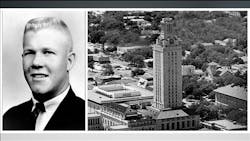As we look back at the history of active shooters in America, it’s obvious that there are some which heavily impact our society to such an extent that it causes a change in protocols in how law enforcement performs its duties. Why would that be? Because “protect and serve” is what we do, and if society demands a change in how we provide that service, we are obligated to comply. Now, obviously there are some limits on that. We can never simply stop enforcing the law, and we can never simply stop responding to calls for service. Beyond that, especially most recently, there is a huge push for a law enforcement profession that is less aggressive and more socially responsive. We’ll look at that in future articles about the active shooter topic, but in this two (maybe three) part series about The Texas Tower incident, we need to recognize that we’re looking at an event that contributed to a shift in how law enforcement worked / works.
- - - - - - - - - -
The remainder of this article is part of the book "Active Killers and the Crimes They Perpetrated," available in print or ebook via Amazon.

Joshua Borelli
Joshua Borelli has been studying active shooter and mass attack events over the course of the past several years, commensurate with receiving training on response and recovery to natural disasters and civil disturbances. Joshua started to outline this series of articles in an attempt to identify commonalities and logistical needs patterns for response.



